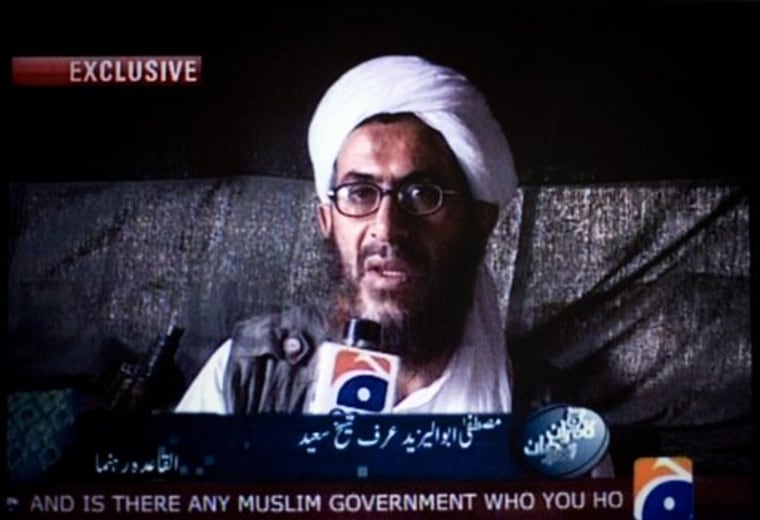The airport shuttle driver accused of plotting a bombing in New York had contacts with al-Qaida that went nearly all the way to the top, to an Osama bin Laden confidant believed to be the terrorist group's leader in Afghanistan, U.S. intelligence officials told The Associated Press.
Mustafa Abu al-Yazid, an Egyptian reputed to be one of the founders of the terrorist network, used a middleman to contact Afghan immigrant Najibullah Zazi as the 24-year-old man hatched a plot to use homemade backpack bombs, perhaps on the city's mass transit system, the two intelligence officials said.
Al-Yazid's contact with Zazi indicates that al-Qaida leadership took an intense interest in what U.S. officials have called one of the most serious terrorism threats crafted on U.S. soil since the 9/11 attacks.
"Zazi working with the al-Qaida core is exceptionally alarming," said Daniel Bynam of the Brookings Institution's Saban Center. "The al-Qaida core is capable of far more effective terrorist attacks than jihadist terrorists acting on their own, and coordination with the core also enables bin Laden to choose the timing to maximize the benefit to his organization."
U.S. intelligence officials said earlier that Zazi had contact with an unnamed senior al-Qaida operative. That helped distinguish Zazi from other would-be terrorists who have acted on their own in planning or attempting U.S. attacks.
The officials, speaking on the condition of anonymity because the case remains under investigation, declined to describe al-Yazid's specific interaction with Zazi, who has pleaded not guilty to conspiring to use weapons of mass destruction. But one senior U.S. intelligence official said the contact between Zazi and the senior al-Qaida leader occurred through an intermediary.
Nature of contact is unclear
It's not clear if al-Yazid, an Egyptian who has worked closely with Osama bin Laden, contacted Zazi to offer simple encouragement or help with the bombing plot prosecutors say Zazi was pursuing.
Just weeks before U.S. intelligence officials identified Zazi as a possible terrorist threat in late August, John Brennan, President Barack Obama's top domestic terrorism adviser, told a Washington audience that "another attack on the U.S. homeland remains the top priority for the al-Qaida senior leadership."
U.S. intelligence officials and prosecutors have said that Zazi was recruited and trained by al-Qaida. They say he and others traveled last year to Pakistan to receive the training.
Prosecutors say Zazi, during meetings with federal investigators before his arrest last month, "admitted that he received instructions from al-Qaida operatives on subjects such as weapons and explosives" during his trip to Pakistan.
Zazi, who is being held without bond in New York while awaiting trial, has denied receiving al-Qaida training or visiting one of the group's training camps. He said before his arrest that he traveled to Pakistan to see his wife, who lives in Peshawar.
In court documents, prosecutors say Zazi is linked to three e-mail accounts that he used to pursue his bomb plot. Investigators say they found nine pages of handwritten bomb-making instructions when searching two of the e-mail accounts. The notes were sent to the e-mail accounts while Zazi was in Pakistan last year, prosecutors say.
The bomb, which can be made of hydrogen peroxide and flour, is similar to the explosives used by terrorists in the 2005 London subway bombings that killed 52 people.
Prosecutors say Zazi accessed the bomb-making instructions and downloaded them on to his computer after moving to the Denver area in January. In a Colorado hotel suite in early September, Zazi contacted someone "on multiple occasions" for help correcting mixtures of bomb ingredients, "each communication more urgent in tone than the last," court papers say.
Al-Yazid, 53, also known as Abu Saeed al-Masri and Sheikh Said, is a well-known al-Qaida figure who initially disagreed with bin Laden's 9/11 plot, according to the 9/11 Commission Report. Al-Yazid was known at the time of the attack as head of al-Qaida's finance committee.
He proclaimed in a June interview with Al-Jazeera television that al-Qaida would use nuclear weapons in its fight against the United States.
A member of Egypt's radical Islamist movement, al-Yazid took part in the 1981 assassination of President Anwar Sadat, according to "In the Graveyard of Empires," a book by counterterrorism expert Seth G. Jones. He spent three years in prison, where he joined Ayman al-Zawahiri's Egyptian Islamic Jihad, Jones wrote. al-Zawahiri is considered al-Qaida's No. 2 leader, behind Osama bin Laden.
Al-Yazid left Egypt for Afghanistan in 1988 and later moved to Sudan in 1991 with bin Laden, serving as his accountant. al-Yazid returned to Afghanistan in 1996 and became a confidant of bin Laden and a member of its Shura Council, according to Jones.
In 2007, al-Yazid took over al-Qaida operations in Afghanistan.
He was reported killed last year in clashes with Pakistani forces near the Afghan border in August 2008 but re-emerged to the surprise of counterterrorism officials.
Terrorism experts say al-Yazid's contact with Zazi in the foiled New York City bombing plot underscores the seriousness of the threat.
"I think that it would suggest the Zazi was taken seriously by Al Qaida, and that they wanted him to feel encouraged and supported," said Charles S. Faddis, who headed the weapons of mass destruction unit at the CIA's Counterterrorism Center until he retired in May 2008.
"It may also have meant that they were attempting to determine to what extent he represented an opportunity to do something inside the United States," Faddis said, who also ran operations against al-Qaida. "For instance, they may have been trying to figure out if they were looking only at an individual or at someone who represented a larger group of jihadists."
